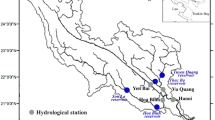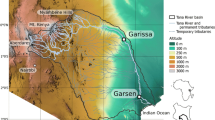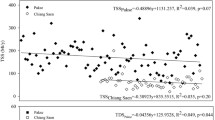Abstract
Finnish rivers exported annually on average 1.2 M t carbon, and total organic carbon (TOC) comprised the major share (nearly 80 %) of this export. The mean area specific carbon export was 4.5 g C m−2 year−1. The highest organic carbon export originated from peat dominated catchments, whereas rivers draining agricultural catchments had the highest area-specific inorganic carbon fluxes. Between 1975 and 2014 total inorganic carbon (TIC) concentrations rose more steadily than the respective TOC concentrations. There was an overall decrease in TOC concentrations between 1975 and the mid-1990s. Decreased point source loading contributed to this pattern, although decreases were also detected in rivers without any major pollution sources. From the mid-1990s TOC concentrations started to rise and the increase was even more pronounced than the earlier decrease. The upward trend was ubiquitous, both in time and space, and it was not possible to link the changes to any specific catchment characteristics or another single driver. Warming climate, changes in hydrology and decreases in acidic deposition were the major driving factors although their contribution varied geographically. At the same time both TOC and TIC export increased slightly, but the strong upward trends in TOC concentrations were not reflected as clearly in TOC export trends. This was because changes in water flow had a dominant influence on TOC export to the sea and any changes in concentrations were masked behind the variation in flow.






Similar content being viewed by others
References
Ågren A, Buffam I, Jansson M, Laudon H (2007) Importance of seasonality and small streams for the landscape regulation of dissolved organic carbon export. J Geophys Res 112:G03003
Algesten G, Sobek S, Bergstrom AK, Agren A, Tranvik LJ, Jansson M (2004) Role of lakes for organic carbon cycling in the boreal zone. Glob Chang Biol 10:141–147
Alling V, Humborg C, Mörth CM, Rahm L, Pollehne F (2008) Tracing terrestial organic matter by σ34S and σ13C signatures in a subarctic estuary. Limnol Oceanogr 53(6):2594–2602
Arvola L, Räike A, Kortelainen P, Järvinen M (2004) The effect of climate and land use on TOC concentrations and loads in Finnish rivers. Boreal Environ Res 9:381–387
Arvola L, Rask M, Ruuhijarvi J, Tulonen T, Vuorenmaa J, Ruoho-Airola T et al (2010) Long-term patterns in pH and colour in small acidic boreal lakes of varying hydrological and landscape settings. Biogeochemistry 101:269–279
Asmala E, Autio R, Kaartokallio H, Pitkänen L, Stedmon CA, Thomas DN (2013) Bioavailability of riverine dissolved organic matter in three Baltic Sea estuaries and the effect of catchment land-use. Biogeosciences 10:6969–6989
Asmala E, Autio R, Kaartokallio H, Stedmon CA, Thomas DN (2014) Processing of humic-rich riverine dissolved organic matter by estuarine bacteria: effects of predegradation and inorganic nutrients. Aquat Sci 76(3):451–463
Aufdenkampe AK, Mayorga E, Raymond PA, Melack JM, Doney SC, Alin SR, Aalto RE, Yoo K (2011) Riverine coupling of biogeochemical cycles between land, oceans, and atmosphere. Front Ecol Environ 9(1):53–60. doi:10.1890/100014
Baker A, Cumberland S, Hudson N (2008) Dissolved and total organic and inorganic carbon in some British rivers. Area 40:117–127
Battin TJ, Luyssaert S, Kaplan LA, Aufdenkampe AK, Richter A, Tranvik LJ (2009) The boundless carbon cycle. Nat Geosci 2:598–600
Berglund J, Muren U, Båmstedt U, Anderson A (2007) Efficiency of a phytoplankton and a bacterial-based food web in a pelagic marine system. Limnol Oceanogr 52:121–131
Brink J, Humborg C, Sahlberg J, Rahm L, Mörth CM (2007) Weathering rates and origin of inorganic carbon as influenced by river regulation in the boreal sub-arctic region of Sweden. Hydrol Earth Syst Sci Discuss 4:555–588
Cai WJ, Hu XP, Huang WJ, Murrell MC, Lehrter JC, Lohrenz SE, Chou WC, Zhai WD et al (2011) Acidification of subsurface coastal waters enhanced by eutrophication. Nat Geosci 4:766–770. doi:10.1038/NGEO1297
Clair TA, Dennis IF, Vet R, Laudon H (2008) Long–term trends in catchment organic carbon and nitrogen exports from three acidified catchments in Nova Scotia, Canada. Biogeochemistry 87:83–97
Clark JM, Bottrell SH, Evans CD, Monteith DT, Bartlett R, Rose R et al (2010) The importance of the relationship between scale and process in understanding long-term DOC dynamics. Sci Total Environ 408:2768–2775
Cole JJ, Prairie YT, Caraco NF, McDowell WH, Tranvik LJ, Striegl RG et al (2007) Plumbing the global carbon cycle: integrating inland waters into the terrestrial carbon budget. Ecosystems 10:172–185
Conley D, Carstensen J, Aigars J, Axe P, Bonsdorff E, Eremina T et al (2011) Hypoxia is increasing in the coastal zone of the Baltic Sea. Environ Sci Technol 45(16):6777–6783
de Wit HA, Mulder J, Hindar A, Hole L (2007) Long-term increase in dissolved organic carbon in streamwaters in Norway is response to reduced acid deposition. Environ Sci Technol 41(22):7706–7713
de Wit HA, Austnes K, Hylen G, Dalsgaard L (2015) A carbon balance of Norway: terrestrial and aquatic carbon fluxes. Biogeochemistry. doi:10.1007/s10533-014-0060-5
del Giorgio PA, Peters RH (1994) Patterns in planktonic P:R ratios in lakes: influence of lake trophy and dissolved organic carbon. Limnol Oceanogr 39:772–787
Denman KL, Brasseur G, Chidthaisong A, Ciais P, Cox PM, Cox R, et al (2007) Couplings between changes in the climate system and biogeochemistry. In: Solomon S, Qin D, Manning M, Chen Z, Marquis M (eds) Climate change 2007: the physical science basis. Contribution of Working Group 1 to the Fourth Assessment Report of the Intergovernmental Panel on Climate Change. Cambridge University Press, pp 499–587
Downing JA, Prairie YT, Cole JJ, Duarte CM, Tranvik LJ, Striegl RG et al (2006) The global abundance and size distribution of lakes, ponds, and impoundments. Limnol Oceanogr 51:2388–2397
Edman M, Omstedt A (2013) Modeling the dissolved CO2 system in the redox environment of the Baltic Sea. Limnol Oceanogr 58(1):74–92
Eimers MC, Watmough SA, Buttle JM (2008) Long–term trends in dissolved organic carbon concentration: a cautionary note. Biogeochemistry 87:71–81
Evans CD, Monteith DT, Cooper DM (2005) Long-term increases in surface water dissolved organic carbon: Observations, possible causes and environmental impacts. Environ Pollut 137:55–71
Evans CD, Chapman PJ, Clark JM, Monteith DT, Cresser MS (2006) Alternative explanations for rising dissolved organic carbon export from organic soils. Glob Change Biol 12:2044–2053
Evans CD, Jones TG, Burden A, Ostle N, Zielinski P, Cooper M et al (2012) Acidity controls on dissolved organic carbon mobility in organic soils. Global Change Biology. doi:10.1111/j.1365-2486.2012.02794.x
Fleming-Lehtinen V, Räike A, Kortelainen P, Kauppila P, Thomas D (2015) Organic carbon concentration in the northern coastal Baltic Sea between 1975 and 2011. Estuaries Coasts 38:466–481
Freeman C, Evans CD, Monteith DT, Reynolds B, Fenner N (2001) Export of organic carbon from peat soils. Nature 412:785
Futter M, Valinia S, Löfgren S, Köhler SJ, Fölster J (2014) Long-term trends in water chemistry of acid-sensitive Swedish lakes show slow recovery from historic acidification. Ambio 43:77–90
Garmo OA, Skjelkvåle BL, de Wit HA, Colombo L, Curtis C, Fölster J, Hoffmann A, Hruška J et al (2014) Trends in surface water chemistry in acidified areas in Europe and North America from 1990 to 2008. Water Air Soil Pollut 225:1880. doi:10.1007/s11270-014-1880-6
Graham LP (2004) Climate change effects on river flow to the Baltic Sea. Ambio 33:235–241
Guo L, Cai Y, Belzile C, Macdonald RW (2012) Sources and export fluxes of inorganic and organic carbon and nutrient species from the seasonally ice-covered Yukon River. Biogeochemistry 107:187–206. doi:10.1007/s10533-010-9545-z
Heino R, Tuomenvirta H, Vuglinsky VS, Gustafsson BG, Alexandersson H, et al (2008) Past and current climate change. In: Bolle H–J, Menenti M, Rasool I (eds) Assessment of climate change for the Baltic Sea basin. Regional climate studies. Springer, Berlin, pp 35–131
HELCOM (2009) Eutrophication in the Baltic Sea—an integrated thematic assessment of the effects of nutrient enrichment and eutrophication in the Baltic Sea region. In: Balt Sea Environ Proc No. 115B
Hirsch RM, Slack JR, Smith RA (1982) Techniques of trend analysis for monthly water quality data. Water Resour Res 18:107–121
Hirsch RM, Alexander RB, Smith RA (1991) Selection of methods for the detection and estimation of trends in water quality. Water Resour Res 27:803–813
Hjalmarsson S, Wesslander K, Anderson LG, Omstedt A, Perttilä M, Mintrop L (2008) Distribution, long-term development and mass balance calculation of total alkalinity in the Baltic Sea. Cont Shelf Res 28:593–601
Hoikkala L, Kortelainen P, Soinne H, Kuosa H (2015) Dissolved organic matter in the Baltic Sea. J Marine Systems 142:47–61
Humborg C, Mörth CM, Sundbom M, Borg H, Bleckner T, Giesler R, Ittekkot V (2010) CO2 supersaturation along the aquatic conduit in Swedish watersheds as constrained by terrestrial respiration, aquatic respiration and weathering. Glob Change Biol 16:1966–1978. doi:10.1111/j.1365-2486.2009.02092.x
Jutterström S, Andersson HC, Omstedt A, Malmaeus JM (2014) Multiple stressors threatening the future of the Baltic Sea-Kattegat marine ecosystem: implications for policy and management actions. Mar Pollut Bull 86:468–480
Jylhä K, Tuomenvirta H, Ruosteenoja K (2004) Climate change projections for Finland during the 21st century. Boreal Environ Res 9:127–152
Köhler S, Buffam I, Jonsson A, Bishop K (2002) Photochemical and microbial processing of stream and soil water dissolved organic matter in a boreal forested catchment in northern Sweden. Aquat Sci 64:269–281
Kortelainen P, Rantakari M, Huttunen JT, Mattsson T, Alm J, Juutinen S, Larmola T, Silvola J, Martikainen PJ (2006) Sediment respiration and lake trophic state are important predictors of large CO2 evasion from small boreal lakes. Glob Change Biol 12:1554–1567. doi:10.1111/j.1365-2486.2006.01167.x
Krug EC, Frink CR (1983) Acid rain on acid soil: a new perspective. Science 211:520–525
Kulinski K, Pempkowiak J (2012) Carbon cycling in the Baltic Sea (Geoplanet: Earth and Planetary Sciences). Springer, Berlin
Lahermo P, Väänänen P, Tarviainen T, Salminen R (1996) Geochemical atlas of Finland, Part 3: environmental geochemistry—stream waters and sediments. Geological Survey of Finland, Espoo, Espoo
Laudon H, Berggren M, Ågren A, Buffam I, Bishop K, Grabs T et al (2011) Patterns and dynamics of dissolved organic carbon (DOC) in boreal streams: the role of processes, connectivity, and scaling. Ecosystems 14:880–893
Lehtoranta J, Ekholm P, Pitkänen H (2009) Coastal eutrophication thresholds: a matter of sediment microbial processes. Ambio 38(6):303–308
Lepistö A, Kortelainen P, Mattsson T (2008) Increased organic C and N leaching in a northern boreal river basin in Finland. Glob Biogeochem Cycle 22:GB3029
Lepistö L, Futter M, Kortelainen P (2014) Almost 50 years of monitoring shows that climate, not forestry, controls long-term organic carbon fluxes in a large boreal watershed. Glob Change Biol 20:1225–1237. doi:10.1111/gcb.12491
Libiseller C, Grimvall A (2002) Performance of partial Mann-Kendall tests for trend detection in the presence of covariates. Environmetrics 13:71–84
Löfgren S, Zetterberg T (2011) Decreased DOC concentrations in soil water in forested areas in southern Sweden during 1987–2008. Sci Total Environ 409:1916–1926
Mattsson T, Kortelainen P, Raike A (2005) Export of DOM from boreal catchments: impacts of land use cover and climate. Biogeochemistry 76:373–94
Mattsson T, Kortelainen P, Räike A, Lepistö A, Thomas DN (2015) Spatial and temporal variability of organic C and N concentrations and export from 30 boreal rivers induced by land use and climate. Sci Total Environ 508:145–154
Meybeck M (1987) Global chemical weathering of surficial rocks estimated from river dissolved loads. Am J Sci 287:401–428
Meybeck M (1993) Riverine transport of atmospheric carbon: sources, global typology and budget. Water Air Soil Pollut 70:443–463
Miller WL, Moran MA (1997) Interaction of photochemical and microbial processes in the degradation of refractory dissolved organic matter from a coastal marine environment. Limnol Oceanogr 42(6):1317–1324
Millot R, Gaillardet J, Dupre B, Allegre CJ (2003) Northern latitude chemical weathering rates: clues from the Mackenzie River Basin, Canada. Geochim Cosmochim Acta 67(7):1305–1329
Monteith DT, Stoddard JL, Evans CD, De Wit HA, Forsius M, Hoegaasen T et al (2007) Dissolved organic carbon trends resulting from changes in atmospheric deposition chemistry. Nature 450:537–540
Omstedt A, Edman M, Claremar B, Frodin P, Gustafsson E, Humborg C, Hägg H, Mörth M (2012) Future changes in the Baltic Sea acid-base (pH) and oxygen balances. Tellus Ser B 64:1–23
Räike A, Pietiläinen OP, Rekolainen S, Kauppila P, Pitkänen H, Niemi J, Raateland A, Vuorenmaa J (2003) Trends of phosphorus, nitrogen and chlorophyll a concentrations in Finnish rivers and lakes in 1975–2000. Sci Total Environ 310:47–59
Räike A, Kortelainen P, Mattsson T, Thomas DN (2012) 36 year trends in dissolved organic carbon export from Finnish rivers to the Baltic Sea. Sci Total Environ 435–436:188–201
Rantakari M, Kortelainen P (2005) Interannual variation and climatic regulation of the CO2 emission from large boreal lakes. Glob Change Biol 11:1368–1380. doi:10.1111/j.1365-2486.2005.00982x
Rantakari M, Kortelainen P (2008) Controls of organic and inorganic carbon in randomly selected Boreal lakes in varied catchments. Biogeochemistry 91:151–162
Rantakari M, Mattsson T, Kortelainen P, Piirainen S, Finér L, Ahtiainen M (2010) Organic and inorganic carbon concentrations and fluxes from managed and unmanaged boreal first-order catchments. Sci Total Environ 408(7):1649–1658
Raymond PA, Cole JJ (2003) Increase in the export of alkalinity from North America’s largest river. Science 301:88–91. doi:10.1126/science.1083788
Reichstein M, Bednorz F, Broll G, Kätterer T (2000) Temperature dependence of carbon mineralisation: conclusions from a long-term incubation of subalpine soil samples. Soil Biol Biochem 32:948–958
Sarkkola S, Koivusalo H, Laurén A, Kortelainen P, Mattsson T, Palviainen M, Piirainen S, Starr M, Finér L (2009) Trends in hydrometeorological conditions and stream water organic carbon in boreal forested catchments. Sci Total Environ 408:92–101
Settele J, Scholes R, Betts R, Bunn S, Leadley P, Nepstad D, Overpeck JT, Taboada MA (2014) Terrestrial and inland water systems. In: Field CB, Barros VR, Dokken DJ, Mach KJ, Mastrandrea MD, Bilir TE, Chatterjee M, Ebi KL et al (eds) Climate change 2014: impacts, adaptation, and vulnerability. Part A: Global and sectoral aspects. Contribution of Working Group II to the Fifth Assessment Report of the Intergovernmental Panel on Climate Change. Cambridge University Press, Cambridge, United Kingdom and New York, NY, USA, pp 271–359
Smith B, Aasa A, Ahas R, Bleckner T, Callaghan TV (2008) Climate related change in terrestrial and freshwater ecosystems. In: Menenti M, Rasool I, Bolle H-J (eds) Assessment of climate change for the Baltic Sea basin. Regional climate studies. Springer, Berlin, pp 221–307
Starr M, Lindroos AJ, Tarvainen T, Tanskanen H (1998) Weathering rates in the Hietajärvi Integrated Monitoring catchment. Boreal Environ Res 3:275–285
Stets EG, Striegl RG (2012) Carbon export by rivers draining the conterminous United States. Inland Waters 2:177–184
Stets EG, Kelly VJ, Crawford CG (2014) Long-term trends in alkalinity in large rivers of the conterminous US in relation to acidification, agriculture, and hydrologic modification. Sci Total Environ 488–489:280–289
Stoddard JL, Jeffries DS, Lukewille A, Clair TA, Dillon PJ, Driscoll CT et al (1999) Regional trends in aquatic recovery from acidification in North America and Europe. Nature 401:575–578. doi:10.1038/44114
Striegl RG, Dornblaser MM, Aiken GR, Wickland KP, Raymond PA (2007) Carbon export and cycling by the Yukon, Tanana, and Porcupine rivers, Alaska, 2001–2005. Wat Resour Res 43. doi:10.1029/2006WR005201
Sundquist ET (1993) The global carbon dioxide budget. Science 259:934–941
Tank SE, Raymond PA, Striegl RG, McClelland JW, Holmes RM, Fiske GJ, Peterson BJ (2012) A land-to-ocean perspective on the magnitude, source and implication of DIC flux from major Arctic rivers to the Arctic Ocean. Global Biogeochem Cycles 26:GB4018. doi:10.1029/2011GB004192
Thrane JE, Hessen DO, Andersen T (2014) The absorption of light in lakes: negative impact of dissolved organic carbon on primary productivity. Ecosystems 17(6):1040–1062
Tranvik LJ, Downing JA, Cotner JB, Loiselle SA, Striegl RG, Ballatore TJ et al (2009) Lakes and reservoirs as regulators of carbon cycling and climate. Limnol Oceanogr 54:2298–2314
Veijalainen N (2012) Estimation of climate change impacts on hydrology and floods in Finland. Doctoral dissertations/Aalto University publication series 55 Aalto University publication series/Doctoral dissertations, ISSN 1799-4942
Vuorenmaa J (2004) Long-term changes of acidifying deposition in Finland (1973–2000). Environ Poll 128:351–362
Vuorenmaa J, Forsius M, Mannio J (2006) Increasing trends of total organic carbon concentrations in small forest lakes in Finland from 1987 to 2003. Sci Total Environ 365:47–65
Weyhenmeyer G, Fröberg M, Karltun E, Khalili M, Kothawala D, Temnerud J, Tranvik LJ (2012) Selective decay of terrestrial organic carbon during transport from land to sea. Glob Change Biol 18:349–355
Worrall F, Burt TP (2007) Flux of dissolved organic carbon from UK rivers. Glob Biogeochem Cycle 21:GB1013
Worrall F, Burt T, Shedden R (2003) Long term records of riverine dissolved organic matter. Biogeochemistry 64:165–178
Zakharova EA, Pokrovsky OS, Dupré B, Gaillardet J, Efimova LE (2007) Chemical weathering of silicate rocks in Karelia region and Kola peninsula, NW Russia: assessing the effect of rock composition, wetlands and vegetation. Chem Geol 242:255–277
Acknowledgments
We thank the Academy of Finland (projects: “Biogeochemistry of the Baltic Sea in a Changing Climate: From Catchment to Open Sea (FiDiPro)” and “Fluxes of Terminal Electron Acceptors: Linking Human Disturbance to the Health of Aquatic Systems (TEAQUILA)” (decision no. 263476)) and NordForsk funded Domqua (Drinking water treatment adaptation to increasing levels of DOM and changing DOM quality under climate change) project for supporting this work. We are grateful to Chris Evans and two anonymous reviewers for their valuable comments on an earlier versions of the manuscript.
Author information
Authors and Affiliations
Corresponding author
Additional information
This article is part of the special issue ‘Carbon Cycling in Aquatic Ecosystems’.
Rights and permissions
About this article
Cite this article
Räike, A., Kortelainen, P., Mattsson, T. et al. Long-term trends (1975–2014) in the concentrations and export of carbon from Finnish rivers to the Baltic Sea: organic and inorganic components compared. Aquat Sci 78, 505–523 (2016). https://doi.org/10.1007/s00027-015-0451-2
Received:
Accepted:
Published:
Issue Date:
DOI: https://doi.org/10.1007/s00027-015-0451-2




